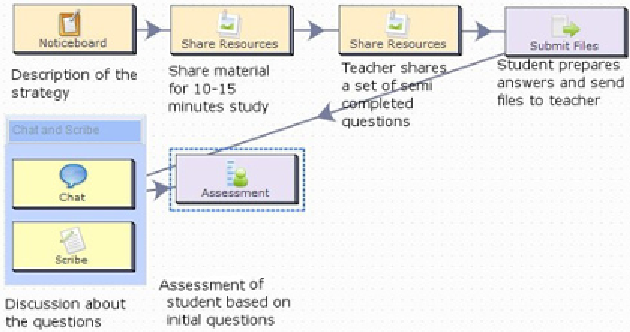Information Technology Reference
In-Depth Information
questions influenced by the well known Bloom
taxonomy. Specifically, this method allows learn-
ers to identify the question patterns of their teacher,
and to recognize more easily the important ideas
to be learned.
Goals
: 1) to encourage critical thinking, 2) to
make the student understand what information is
important, 3) to help in the introduction of previ-
ously unknown material, 4) to stimulate discussion
on specific subject.
Process
: 1) Present the problem, 2) Study the
material for 10-15 minutes, 3) Teacher shares a
set of semi-completed questions, 4) Each student
prepares the answers to questions and submits
them to the teacher, 5) Discussion on the subject,
6) Assessment based on the given questions.
A diagrammatic representation of this method
-as a design pattern within LAMS- is presented
in Figure 7.
learners with little prior knowledge will gain a
better understanding of the subject because of
the participation in the interviews.
Goals
: 1) team building, 2) reinforcement
of the comprehension of information based on
lectures or textbooks, 3) students engagement in
conversation.
Process
: 1) Sharing of material, 2) Assignment
of the roles of the interviewer and interviewee,
3) Formation of a team, 4) Timed discussion and
inversion of roles, 5) Formation of groups with 4
members, 6) Discussion between pairs.
A diagrammatic representation of this method
-as a design pattern within LAMS- is presented
in Figure 8.
5.8. Paired Annotations
Millis and Cottel (1998) suggest this method as
capable of improving the ability of learners to
comprehend faster. The main idea is the forma-
tion of student pairs who try to identify key ideas.
The frequent alternation of the pairs may help
the further development of metacognitive skills.
Goals
: 1) to enable students to identify key
points, 2) to develop literature review skills, 3) to
encourage students to make connections between
5.7. Three Step Interview
The
Three Step Interview
(Kagan, 1994) can be
used as a tool to support the better comprehen-
sion of ideas through discussion with peers. Each
learner listens to others' opinions, enriching their
cognition about the specific topic. Even the weaker
Figure 7. Implementation of the method of Guided Reciprocal Questioning as a design pattern within
LAMS

Search WWH ::

Custom Search